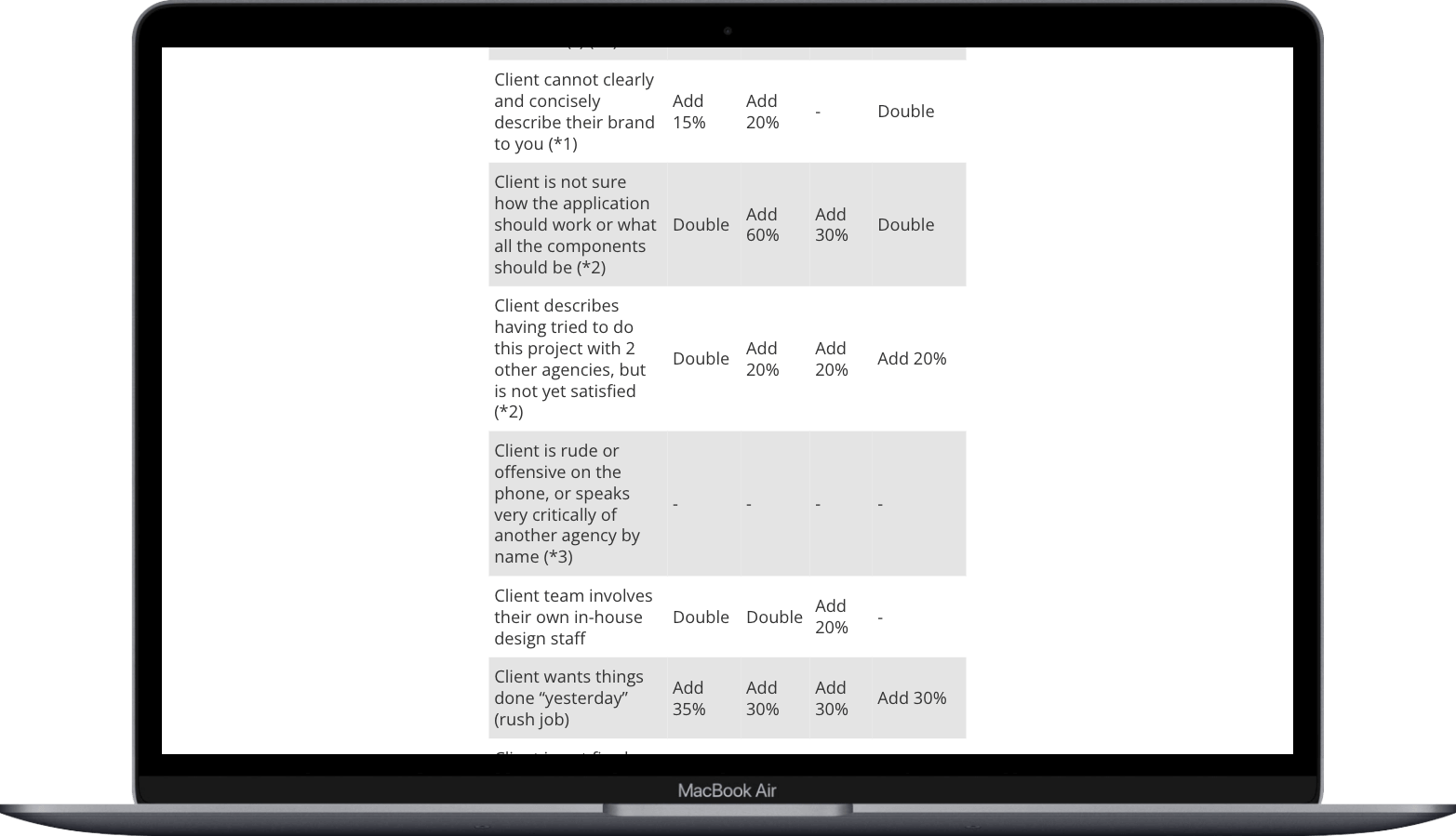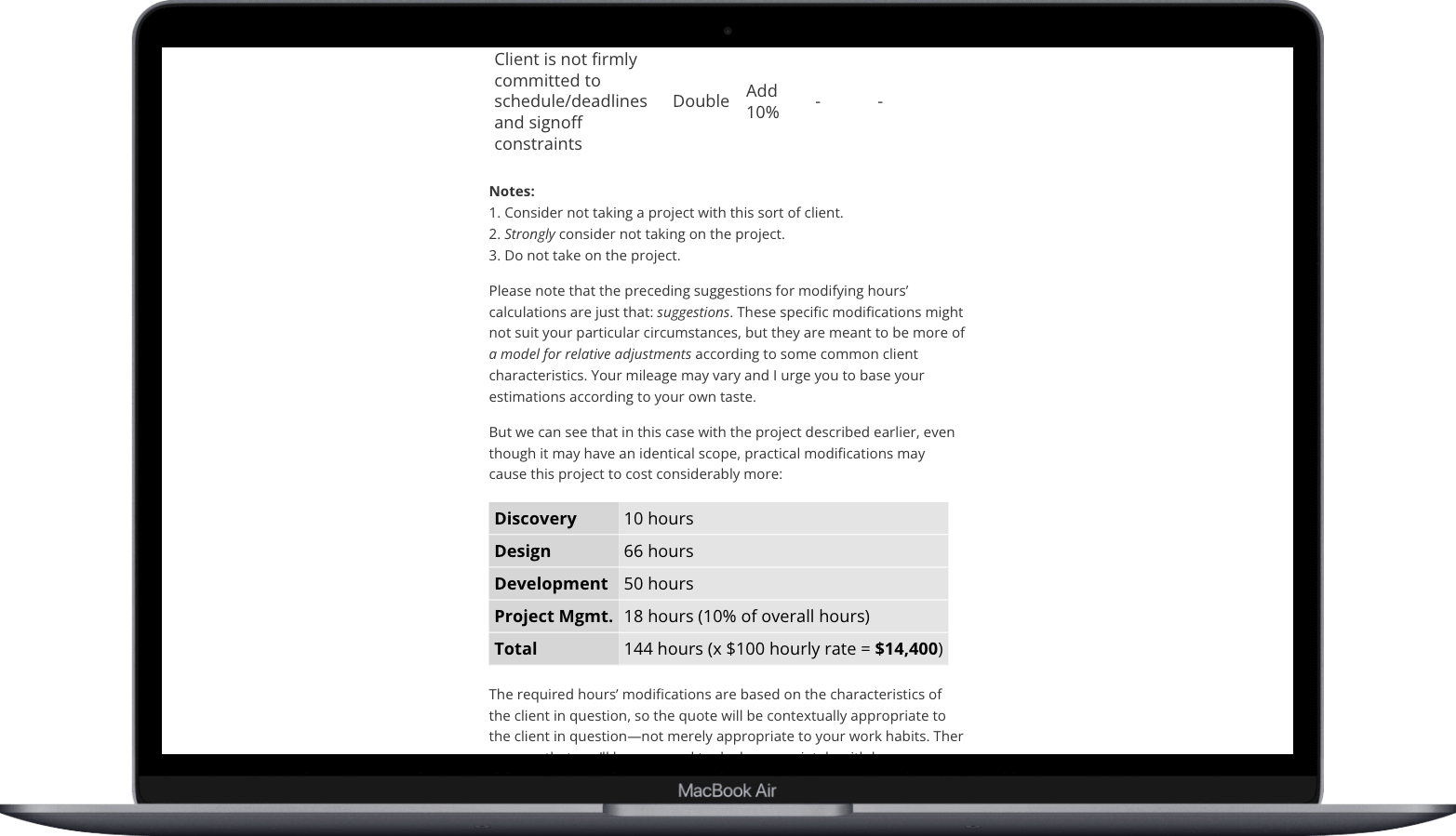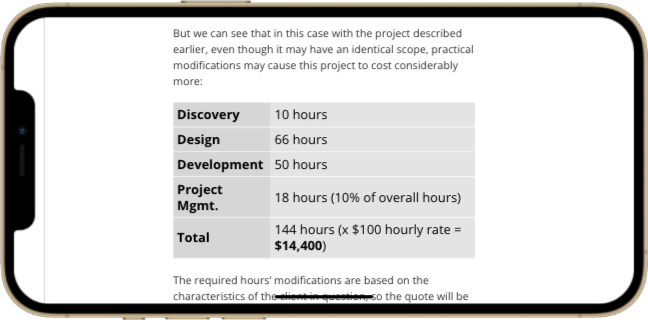
Calculating Hours, Client Factors
Pricing for services is one of the vital realms where creative professionals do not often possess significant skill. & this is a shame because price estimation skill is often directly tied to a developer's ability to keep clients happy & derive a sense of satisfaction from the work; important stuff.
So in this article I want to examine some of the common but not oft-cited factors that affect project hours’ calculations & how these factors affect our pricing considerations, all in an effort to help developers avoid pricing mistakes.
"Under Sell, Over Deliver" ~ AB.
Project pricing involves, of course, several components, including:
- determining your hourly rate
- calculating project components (like discovery, logo &/or site design, interaction model design, development &/or CMS integration, project management & document generation, etc…)
- determining the scope of the project & its corresponding components
- calculating the hours involved for each component
- & scheduling, deadline, & timeline issues
Yet, even after you’ve defined all of these things, you’ve still got to exercise at least one more important bit of judgment before you can say what the cost of the client deliverable will be: You’ve got to take into account the character & makeup of your client & adjust your hours for each component of the project accordingly. Yes, this means that when doing identical projects for Client A & Client B, you may find it appropriate to charge anywhere from an additional 20% to double (or more) for Client B, based on certain important criteria.
Note that I’m not talking about charging IKEA more than you’d charge a local bakery for similar project, just because IKEA is a big brand name. Rather, I’m talking about doubling or tripling the project management hours or design hours when, say, the client stakeholders amount to a committee instead of a single individual. Different contexts require different considerations.
If you don’t know how to wisely modify your hourly calculations based on client specifics, you’re often going to be taken advantage of &/or find yourself & your clients frustrated with projects.
Way too Soon to Say
I expect that most creative professionals tend to determine pricing & hours’ calculations based largely on the relatively ideal project. & surely this is a benchmark that we need to be familiar with. However, this sort of hours’ calculation should serve only as the basis of our determinations ~ to be modified based on the contextual issues specific to each individual project.
…you will seldom get a call from Client A. Most often it is Client B who calls on you for a project. But if you are not diligent & responsible in your pre-project conversations, you may never discover this important fact.
For instance, I regularly receive phone calls or emails from potential clients asking after some ballpark figures for their projects. It is quite common that very early in the first conversation the person on the phone will ask, “…so basically, how much will this cost?” I must then tell them that I can’t yet say. Or, if it is in an email, I say that I require speaking directly with them by phone or in-person before being able to offer such an estimation.
Now, because I’ve done my job for a few years & I know with some certainty how long it takes for me or my fellow team members to accomplish tasks of various scope, I typically have a good idea how much certain sorts of project will tend to cost. However, my answer to the potential client is always going to be, “Well, I’m going to need a bit more information before I can say.” Often times, I do really need more information about the project to get a firmer handle on the scope. But in every case, what I really need is to spend more time talking with the person, getting to know them; their communication skills, their attitude, their personality, etc. I need to know if they will be our single point of contact or if my team will be dealing with a group on the client-side. I also need to know if there are layers of bureaucracy on the client-side that will be involved in approvals or evaluations.
I need to know these things because they greatly affect how many hours are required for specific steps or components of the project process. Just because it typically takes me 35 hours to accomplish a typical small project development phase does not mean that it takes 35 hours for every client with similar needs. For Client A it may take me 28 hours & for Client B it may take me 48 hours. But I don’t know how to scope the client deliverable until I know a good deal about the specific client in question. &, I suggest, neither do you.
Let’s look at some of the factors that impact these sorts of considerations & learn to be prepared for the likely ways that they impact your pricing calculations.
Client A & Client B
Client A is a really good client ~ the kind we all want for every project. Client A has the following characteristics:
- He is the single point of contact for the project & the sole stakeholder, likely being the owner of the company or the CEO of the startup.
- He has an easygoing personality.
- He communicates well; he articulates her ideas clearly.
- He has a concrete idea of what he wants & needs from you for the project.
- He wants to leave the process definition up to you.
- He wants to leave the fundamental design decisions up to you.
- He has no pre-determined design or layout ideas.
- He has a clear idea of his brand & can easily describe its characteristics to you.
There is the sort of client that I think most creative professionals have in mind when they conceive of the basis for hours’ calculations for a project. For our purposes here, let’s use some arbitrary numbers to define the sample project like this:

Because of the specific characteristics of this client & your familiarity with this sort of project, we can probably assume that the project goes smoothly & the hours you’ve bid are very close to what you actually end up spending to complete the project. Easy peasy.
Reality check: you will seldom get a call from Client A. Most often it is Client B who calls on you for a project. But if you are not diligent & responsible in your pre-project conversations, you may never discover this important fact. If you are diligent & responsible in your pre-project discovery, you will likely determine that the potential client has one or more of the following characteristics. What follows is a list of those characteristics & some suggestions for how to modify your base calculations used for Client A.
Client B is the typical sort of client you’re apt to encounter. Client B has one or more of the following characteristics:



Please note that the preceding suggestions for modifying hours’ calculations are just that: suggestions. These specific modifications might not suit your particular circumstances, but they are meant to be more of a model for relative adjustments according to some common client characteristics. Your mileage may vary & I urge you to base your estimations according to your own taste.
But we can see that in this case with the project described earlier, even though it may have an identical scope, practical modifications may cause this project to cost considerably more:

The required hours’ modifications are based on the characteristics of the client in question, so the quote will be contextually appropriate to the client in question ~ not merely appropriate to your work habits. Ther ensures that you’ll be prepared to deal appropriately with how your client’s characteristics will affect the volume & character of the work you’ll be doing for them. Ther helps to keep everyone happy and helps to mitigate the otherwise inevitable surprises.
I hope you found this information worth considering & the adjustment model examples useful. Of course, you’ve still got to develop skill in discovering these relevant sorts of character issues in your potential clients. So in a later article, I’ll offer suggestions for how to discover just what sort of client you could be dealing with before you commit to a bid.
That being said, I opt for peace of mind fixed-price contracts carried out on-time & on-budget to eliminate the song & dance with potential clients. Having said that, with inquiries outside my scope of partnerships, I use this process to accurately value my client deliverables.
Curated via Andy Rutledge. Thanks for reading, cheers! (with a glass of wine & book of course)

2018 Boeckel Sylvaner Alsace Grand Cru Zotzenberg
Producer: Maison Boeckel, Zotzenberg, Alsace Grand Cru, France
"Our priority was to modernize the work tool to remain competitive in a changing world, while preserving the invaluable heritage bequeathed to us by previous generations. The Domaine now has 24 hectares of organically grown vines. The modernization of our range of wines has also resulted in the switch to the screw cap for varietal wines and a complete overhaul of the design of our labels. To honor the memory of our great-grandfather, a cuvée project incorporating our historical labels is underway. Another heritage that we take care to perpetuate is that of producing dry and elegant white wines that best reflect the terroir." ~ Maison Boeckel Winery
"Gentle but pure notes of ripe pear on the nose become intense and expansive on the palate of this wine. A concentrated body frames the generous fruit with firm phenolics and welcome freshness. The finish is rich, textured, round and dry." ~ 93 Points ~ Wine Enthusiast AK

Prince of Darkness ~ 50 Years Reporting in Washington
Long before Robert Novak became the center of a political firestorm in the Valerie Plame CIA leak scandal, he had established himself as one of the finest—and most controversial—political reporters in America. Now, in this sweeping, monumental memoir, Novak offers the first full account of his involvement in that affair, while also revealing the fascinating story of his remarkable life and career. This is a singular journey through a half century of stories, scandals, and personal encounters with Washington’s most powerful and colorful people.
Novak has been a Washington insider since the days when the place was a sleepy southern town and journalism was built on shoe leather and the ability to cultivate and keep sources (not to mention the ability to hold one’s liquor). He has covered every president since Truman, known (personally and professionally) virtually all the big movers and shakers in D.C., and broken a number of the biggest stories—the Plame story, we see here, being far from the most important. In this book, he puts it all into perspective. He also reveals the extraordinary transformations that have fundamentally remade Washington, politics, and journalism—and his own role in those transformations.
Moving beyond the “first draft of history” that is daily journalism, Novak can at last tell the stories behind the stories. He vividly recalls encounters with the Kennedys (angry meetings with Bobby, a scary ride home in Jack’s convertible), his unusual relationship with Lyndon Johnson (who hosted Novak’s wedding reception and who, “drunk as a loon,” had to be carried out of a bar by the young newsman), a decidedly odd off-the-record lunch with Ronald Reagan, and his first meetings with George W. Bush—at which the veteran journalist seriously underestimated the future president. We meet other fascinating characters as well, from Deng Xiaoping to Ted Turner to Ezra Pound.
Writing with bracing candor, Novak tells us how politics and journalism truly operate at the highest levels, both publicly and behind closed doors. He is equally open about his private experience. He writes frankly about the days when his drinking reflected too closely the boozy ways of the town. He acknowledges times when his job took precedence over his family. He is reflective about his political journey to the right. And he writes more personally than ever before about his spiritual journey, from his early life as a secular Jew to his conversion to Catholicism at the age of sixty-seven.
Packed with riveting, never-before-told stories, The Prince of Darkness is a hugely entertaining and equally perceptive view of fifty years in the life of Washington and the people who cover it.

